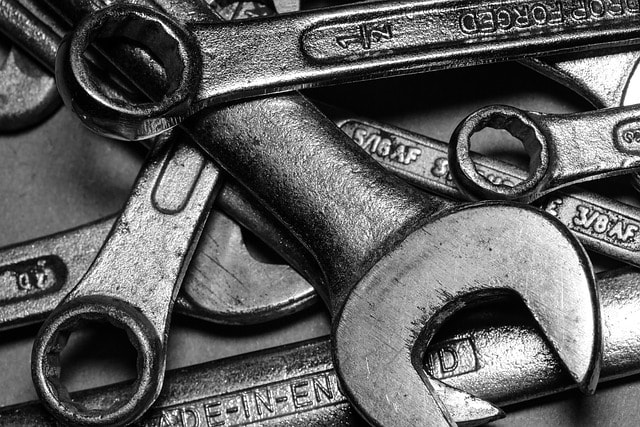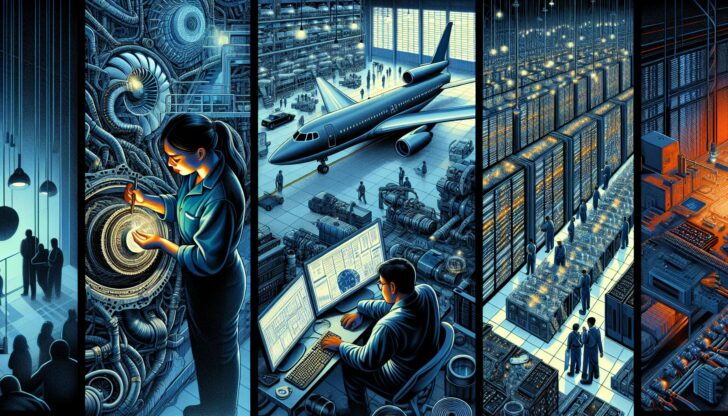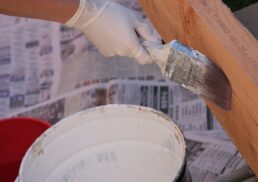Maintenance involves regular inspections and repairs to keep equipment running smoothly and safely. This guide will explain why maintenance matters, explore different types of maintenance, and offer strategies for effective maintenance routines.
Table of Contents
Key Takeaways
Maintenance involves regular inspections, repairs, and upkeep of systems and machinery to prevent unexpected breakdowns and ensure safety and efficiency.
The main types of maintenance practices include routine, preventive, corrective, and predictive maintenance, each with specific purposes and benefits.
Effective maintenance strategies, industry-specific practices, and appropriate training and tools are crucial in overcoming challenges like downtime, managing maintenance costs, and retaining skilled workers.
Understanding Maintenance

Maintenance is the process through which the good working condition of buildings, machinery, and systems is upheld via regular inspections, repairs, and upkeep. The primary objective of maintenance is to render repairs redundant by keeping equipment in optimal condition, which prevents unexpected breakdowns and guarantees safety. This involves a variety of activities, including:
Functional checks
Servicing
Repairing
Replacing necessary devices, equipment, and infrastructure.
The scope of maintenance is vast and includes both tangible and intangible elements. It encompasses:
Routine inspections
Cleaning
Monitoring
Adjusting machinery to keep it functioning properly
Maintenance activities are essential to retain or restore an item to a state where it can perform its required functions, using prescribed procedures and resources. Over time, maintenance terminology has become standardized, including terms like maintenance, repair, and overhaul (MRO).
Maintainability, a crucial aspect to include during the utilization stage of a product or system, is intimately linked to maintenance. This is pivotal for the product or system’s long-term functionality and efficiency. The Department of Defense defines maintenance as actions taken to retain or restore material to a serviceable condition. This definition highlights the importance of maintaining equipment not only for operational efficiency but also for safety and reliability.
Types of Maintenance

Different types of maintenance practices help organizations manage assets efficiently and prevent unexpected breakdowns. These practices can be broadly categorized into four main types:
Routine Maintenance
Preventive Maintenance
Corrective Maintenance
Predictive Maintenance
Each type has its own specific purposes and benefits, tailored to meet different operational needs.
Routine Maintenance
Routine maintenance entails regular activities like inspecting, cleaning, and replacing parts to avert equipment failure. Implemented on a fixed schedule, routine maintenance includes tasks like lubricating, minor adjustments, and cleaning, ensuring machinery operates smoothly. These activities are essential for maintaining equipment in good working condition and preventing minor issues from escalating into major problems.
Routine maintenance ensures that facilities can be continuously used at their designed capacity. Common activities include regular cleaning, monitoring, and inspecting. By performing these tasks, maintenance crews can detect and address potential issues early, reducing the risk of unexpected breakdowns and extending the lifespan of equipment.
Preventive Maintenance
Preventive maintenance involves carrying out scheduled tasks designed to preempt problems through routine checks and servicing. This approach helps prevent minor issues from escalating into major problems by conducting regular inspections and maintenance. Preventive maintenance is performed while equipment is still operational to avoid unexpected breakdowns.
A preventive maintenance schedule helps organize and prioritize maintenance tasks, ensuring equipment operates efficiently and safely. This proactive approach can extend the lifespan of assets, reduce maintenance costs, and minimize unplanned downtime. By keeping up with preventive maintenance, facilities can run more efficiently and maintain a higher level of productivity.
Corrective Maintenance
Corrective maintenance refers to the process of executing maintenance tasks on equipment following a breakdown or malfunction. This type of maintenance is activated when equipment performance drops or fails, with the primary purpose of restoring the equipment to its optimal functioning condition as quickly as possible. While corrective maintenance is essential for addressing unforeseen issues, it often leads to significant costs due to downtime and the resources required for repairs.
Advanced troubleshooting techniques are crucial in corrective maintenance to diagnose equipment issues efficiently, minimizing downtime and ensuring effective repairs. Despite its reactive nature, corrective maintenance is a necessary component of a comprehensive maintenance strategy, ensuring that equipment can be swiftly returned to operational status after a failure.
Predictive Maintenance
Predictive maintenance employs data and condition monitoring to anticipate the optimal time for maintenance, thereby avoiding unexpected failures and minimizing downtime. The primary goal is to:
Predict when a machine will start experiencing severe wear and tear
Allow for convenient scheduling of corrective maintenance
Transform unplanned downtime into planned downtime by using predictive analysis tools to anticipate equipment failures.
Predictive maintenance relies on data to identify when equipment parameters deviate from norms, indicating potential failures. Techniques such as vibration analysis, infrared thermography, and ultrasonic analysis are used to monitor equipment condition in real-time. By employing predictive maintenance, organizations can optimize equipment performance, reduce maintenance costs, and enhance overall reliability.
Benefits of Proper Maintenance
Appropriate maintenance considerably lowers the risk of equipment breakdowns, thus preserving productivity and reputation. Equipment that undergoes regular maintenance runs more efficiently, which is measured by key performance indicators like Overall Equipment Effectiveness (OEE). Tracking asset life effectively can also extend its lifespan and reduce maintenance costs.
Maintaining equipment promotes health and safety within facilities by ensuring clean air from HVAC systems through regular filter and coil cleaning. Additionally, effective maintenance can boost customer satisfaction by ensuring the consistent quality of products and creating a reliable brand image. The benefits of proper maintenance extend beyond operational efficiency, impacting safety, costs, and customer trust.
Maintenance Strategies
An effective maintenance strategy involves combining different approaches tailored to the specific needs of the industry. Standard Maintenance Procedures (SMPs) standardize both regular and unplanned critical tasks to ensure consistent task quality. Researchers and organizers play a crucial role in preparing and managing maintenance activities to improve equipment performance.
Planned Maintenance
Planned maintenance revolves around the use of a schedule for carrying out maintenance tasks, which guarantees equipment reliability and curtails unexpected breakdowns. Maintenance planning is essential for these activities, which often include:
Inspections
Cleaning
Lubrication
Parts replacement
These tasks are performed according to a predetermined schedule. A maintenance plan helps in scheduling tasks, controlling machine stops, and ensuring equipment operates at an acceptable level.
By implementing planned maintenance, organizations can:
Minimize unexpected downtime
Extend the lifespan of their assets
Ensure that equipment is always in optimal working condition
Reduce the need for emergency repairs and the associated costs.
Condition-Based Maintenance
Condition-based maintenance (CBM) leverages real-time monitoring and scheduled inspections to evaluate equipment condition, carrying out maintenance only as necessary. This approach prioritizes and optimizes maintenance resources using real-time data, avoiding unnecessary resource waste due to a preset schedule. Techniques such as:
Vibration analysis
Infrared thermography
Ultrasonic analysis
Oil analysis
Electrical analysis
Pressure analysis
are employed to monitor equipment condition.
CBM aims to minimize downtime and reduce maintenance costs by performing maintenance tasks based on the actual condition of equipment rather than a fixed schedule. Forecasting and sourcing parts can be challenging, especially with diverse equipment brands, but the benefits of targeted maintenance outweigh these difficulties.
Continuous Improvement in Maintenance
Continuous improvement in maintenance requires frequent evaluation and enhancement of maintenance processes, aiming for increased efficiency and effectiveness. Total Productive Maintenance (TPM) engages the entire workforce in maintenance activities, fostering a culture of continuous improvement. This approach not only improves equipment reliability but also empowers employees to take ownership of maintenance tasks.
By adopting a continuous improvement mindset, organizations can:
Identify and eliminate inefficiencies in their maintenance processes
Regularly update maintenance strategies
Incorporate feedback from maintenance crews
Ensure that the maintenance program evolves with changing needs and technological advancements.
Industry-Specific Maintenance Practices

Different industries require specific maintenance practices to ensure optimal performance and safety. Marine and air transportation, offshore structures, and industrial plant and facility management are some of the sectors that depend heavily on maintenance, repair, and overhaul (MRO). Each industry has unique requirements and challenges that necessitate tailored maintenance approaches.
Aerospace Maintenance
In the aerospace industry, robust maintenance practices are pivotal to prevent high-fatality disasters and guarantee safety. The Federal Aviation Administration (FAA) mandates several maintenance inspections. These include the 100-hour inspection, annual inspection, and progressive inspection.
These strict regulations ensure that all aircraft are maintained to the highest safety standards.
Manufacturing Maintenance
In the manufacturing industry, effective machine maintenance is crucial in preventing breakdowns and ensuring smooth operations. Condition-Based Maintenance (CBM) is a crucial tool for running a plant or factory optimally, leading to lower production costs and reduced use of resources.
By employing CBM, manufacturers can ensure that machinery operates efficiently and reliably.
IT and Computer Maintenance
Key maintenance activities for IT systems encompass server maintenance and IT risk assessments. Regular maintenance ensures that IT infrastructure operates smoothly, reducing the risk of system failures and data loss.
By performing routine checks and updates, IT professionals can maintain the integrity and performance of their systems.
Check out 10 Essential Computer Maintenance Tips.
Maintenance Training and Tools
Appropriate training and specialized tools are indispensable for maintenance personnel to keep abreast of rapidly advancing technology and industry standards. Training helps maintenance staff effectively operate, maintain, and repair new and technologically advanced equipment. This ensures that maintenance crews can perform their tasks efficiently and safely.
Maintenance Training Programs
Regular training helps maintenance personnel keep pace with technological advancements. Technical training programs cover various systems, including:
Electrical
Mechanical
Hydraulics
Pneumatics
Control systems
On-the-job training allows maintenance personnel to gain practical skills directly applicable to their work environment.
Essential Maintenance Tools
Maintenance personnel often use specialized tools and equipment for diagnosing and repairing faults. These tools include testing and inspection devices for regular equipment checks, ensuring that all systems are functioning properly. Having the right tools is essential for effective and efficient maintenance operations.
Common Challenges in Maintenance
Typical challenges in maintenance include:
Finding and retaining skilled workers
Reducing downtime
Managing costs
Implementing condition-based maintenance
These challenges can significantly impact the effectiveness of poor maintenance programs and the overall performance of equipment and systems.
Dealing with Downtime
Downtime denotes a period when a system is not operational. Unplanned downtime, caused by unforeseen circumstances like unexpected equipment breakdowns, can lead to major profit losses, especially in the industrial and IT sectors.
Developing emergency maintenance procedures and investing in fault-tolerant equipment can help reduce downtime and maintain productivity.
Managing Maintenance Costs
Without a regular maintenance program, catastrophic failures can result in higher corrective maintenance costs. High setup costs for predictive maintenance are offset by long-term savings from improved equipment performance and reduced failures.
Tracking the economic life of assets helps in reducing long-term maintenance costs and optimizing resource allocation.
Summary
In summary, effective maintenance practices are essential for ensuring the reliability, safety, and efficiency of equipment and systems across various industries. By understanding and implementing different types of maintenance, such as routine, preventive, corrective, and predictive maintenance, organizations can significantly reduce the risk of unexpected breakdowns and extend the lifespan of their assets.
Maintenance strategies that include planned maintenance, condition-based maintenance, and continuous improvement can further enhance the effectiveness of maintenance programs. Proper training and the use of specialized tools are also crucial for maintaining equipment and ensuring that maintenance personnel are equipped to handle advanced technologies. By addressing common challenges such as downtime and maintenance costs, organizations can optimize their maintenance operations and achieve long-term success.
Frequently Asked Questions
What is the primary goal of maintenance?
The primary goal of maintenance is to ensure that buildings, machinery, and systems are kept in good working condition through regular inspections, repairs, and upkeep to prevent unexpected breakdowns and ensure safety.
What are the different types of maintenance?
The different types of maintenance are Routine Maintenance, Preventive Maintenance, Corrective Maintenance, and Predictive Maintenance. Each type serves specific purposes and benefits tailored to different operational needs.
How does preventive maintenance benefit organizations?
Preventive maintenance benefits organizations by preventing minor issues from becoming major problems through regular inspections and maintenance. This approach extends the lifespan of assets, reduces maintenance costs, and minimizes unplanned downtime.
What challenges are commonly faced in maintenance?
In maintenance, common challenges include finding and retaining qualified workers, minimizing downtime, managing costs, and implementing condition-based maintenance.
Why is training important for maintenance personnel?
Training is important for maintenance personnel to stay updated with rapidly advancing technology and industry standards, ensuring they can effectively operate, maintain, and repair new and technologically advanced equipment. This helps in maintaining efficiency and safety in the workplace.









